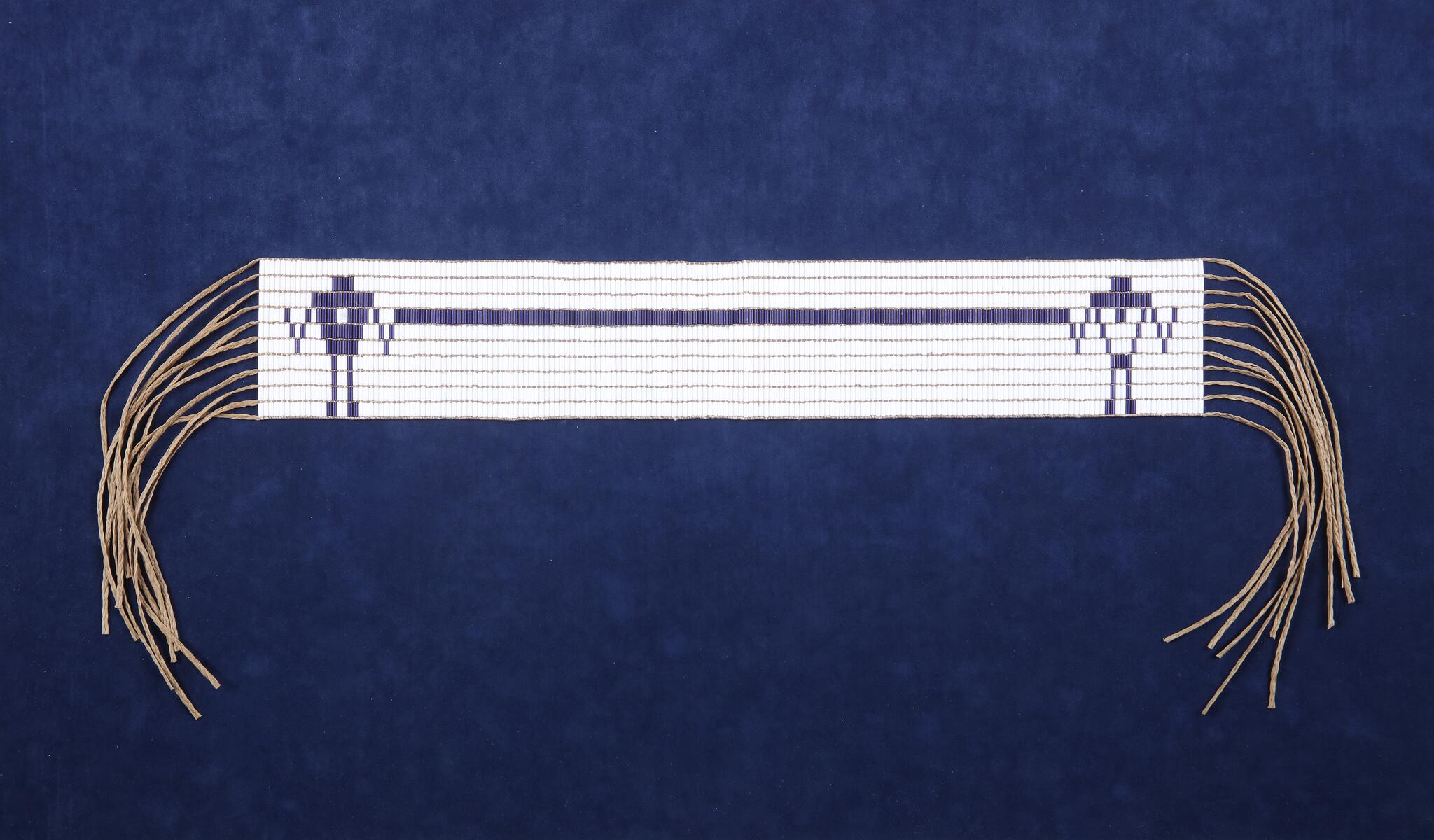Tehontatenentsonterontahkhwa
Skén:nen Atenro’será:kon tánon Ka’nikonhrí:io
Wa’kón:ion ne Queen’s University tsi iohétstha ne kaianerénhsera ne Kaswéntha Atenro’será:kon atia’táhnha, né ne Konti’tarí:sere Ka’nisténhsera takóntka’we Tyendinaga nitioné:non tánon ne Kahsóhtshera Iotitióhkwaien ne Kingston kí 7 shískare Enniskó:wa 2017.
Kí kakweniénston ate’nienténhtshera tiókonte e’tho káien nó:nen enhontkenní:sa ne ratiianerenhserón:nis, ne wathró:ris tsi enká:take tsi waterihwahserón:ni ne Skén:en tánon Atenro’será:kon.
Peace, Friendship and Good Minds
The friendship wampum belt was presented to Queen's University Senate by the Clan Mothers at Tyendinaga, and the Grandmothers' Council of Katarokwi, on March 7, 2017.
To learn more about wampum, you may be interested in this video from Richard Hill, a Tuscarora scholar and expert in this field.

Senate Meetings
As members of Queen’s Senate, we acknowledge that we are on the traditional lands of the Anishinaabe and Haudenosaunee people. Learning and growth requires exploration of one’s identity, an exploration that can only take place in the true commitment to reconciliation.
As members of Senate, we recognize our role in this process of exploration and we acknowledge that learning must also involve recognizing the consequences of actions and the responsibility to move forward with a positive spirit. We acknowledge the wampum on the table before us, which serves as a reminder of the peace, friendship, and good minds that we commit and recommit to each time we meet.
These lands situate us in place while reminding us of our past.
This cherished symbol is present at all Senate meetings, to represent the lasting covenant of peace and friendship.

Wampum belts during the 2023 Polishing the Chain ceremony
Photo: Bernard Clark
The Metaphor in Historical Context
“Polishing the Chain” developed from the relationship between the Haudenosaunee and the British in the 17th & 18th centuries. This time is known as the era of wampum diplomacy for its reliance upon Haudenosaunee diplomatic protocols to govern the relationship between the Haudenosaunee and European nations. These diplomatic protocols were (and are) anchored in a collection of images and metaphors which were codified in stories, speeches, and wampum belts. These metaphors and images were foundational to the shared relationship between the two entities.
Kahswéntha / The Two Row Wampum
While the date of the Two Row is disputed between Haudenosaunee and European scholars, the image and concept date to an early period in the relationship between the Haudenosaunee and the Europeans. The Two Row wampum records two parallel lines representing the Indigenous canoe and the European ship travelling alongside each other on the river but not coming together. The agreement visually codifies how the relationship is to proceed into the future as co-equal and mutually interdependent sovereignties.
The Silver Covenant Chain
As the relationship developed between the Haudenosaunee and the British in the 17th century, a chain of three links was added to the collection of shared metaphors in the service of diplomacy. This chain was forged with three links which represent the shared ideals of peace, friendship, and continuity* between the two nations that would bind them together as allies and friends. And so, ‘polishing the chain’ became a metaphor for the proactive maintenance of a relationship which needed care and regular attention to maintain its beauty clearly visible to everyone. In times of trouble, the relationship between the Haudenosaunee and the British could become tarnished which would indicate to all that a gathering was required to bring the silver chain back to its polished state. And in times of extreme storm or distress, there was always the risk that the chain could be broken and the relationship severed. *The meaning of the third link is variously reported as ‘forever’/ continuity, strength, and respect, among others.
Polishing the Chain
The chain was polished through regular meetings and discussions of shared business. In the early years of the relationship, these meetings followed Haudenosaunee diplomatic protocols. These protocols were utilized 16 strings of wampum that served as both a tool with spiritual strength to accomplish their goal and a mnemonic device for the person delivering the accompanying speeches. These strings would symbolically clear the path of any obstacles, remove the clouds from the sky, and shake off the dust of travel. Council records from the time show that the 16 strings of wampum were used, rearranged, and adapted to meet the needs of the varied situations and encounters.
Meeting Places and Spaces
There was no specific formula for polishing the chain and it could happen in any number of ways or places. Essentially, the act of meeting and mutual recollection of the story kept the chain polished. A meeting would be called for a specific purpose and typically only one major piece of business would be discussed. The invitation was sent via runners to the invitees who would take wampum and announce the time and place of the meeting. Accepting the string of wampum indicated that the invitee would a]end the meeting and conversely, rejecting the wampum string indicated that the party would not attend the meeting.
Polishing the Chain at Queen’s
When we gather to polish the chain at Queen’s, we come together as two co-equal parties to recognize the importance of our relationship with each other and renew the friendship we’ve built over the years.
Polishing the Chain Ceremonies

A Polishing the Chain ceremony took place on October 5 to recognize and renew the ongoing relationship between the university and Indigenous communities. Senior leaders, Queen's senators, staff, faculty, students, and Indigenous community members came together at the new outdoor Indigenous gathering space, located at the south end of Tindall Field.
